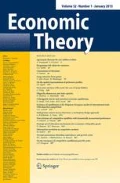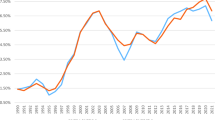Abstract
The literature on small open-economy models with collateral constraints has provided the theoretical grounds for macroprudential regulations. This paper examines a subsidy on debt during a crisis as a form of bailout in comparison with prudential capital controls. We show that the policy prescription on bailouts differs substantially between the timing assumptions of the collateral constraint of households. If borrowing is constrained by the value of assets that households have purchased before they borrow, the bailout is neutral, suggesting that prudential capital controls are preferable. If, on the other hand, households collateralize their assets that they purchase at the same time as their borrowing, the bailout replicates the unconstrained allocation without collateral constraint and outperforms prudential capital controls. Even in the latter case, however, our numerical experiments suggest that such bailouts restoring the unconstrained allocation may not be implementable in terms of its size and frequency.


Similar content being viewed by others
Notes
More recent papers include Jeanne and Korinek (2010b, 2013), Benigno et al. (2012, 2013, 2014), Bianchi and Mendoza (2013), Korinek and Simsek (2014), Dávila (2015), and Bianchi (2016). Farhi and Werning (2012, 2013) and Schmitt-Grohé and Uribe (2012, 2015) argue for prudential capital controls under nominal price or wage rigidities.
See also Benigno et al. (2012) and Jeanne and Korinek (2013) for the case where multiple policy instruments are available for crisis management. Schmitt-Grohé and Uribe (2015) show that the open-economy model with downward nominal wage rigidities can give rise to pecuniary externalities. They argue that bailouts by devaluation of the country’s currency could restore the unconstrained allocation. Likewise, using a model of banking, Green (2010) argues that bailouts can lead to a socially efficient outcome.
We consider a slightly more general constraint than JK because they assume \(\phi =1\).
See footnote 4 in JK.
Following Jeanne and Korinek (2013), our policy analysis rules out the possibility that the government uses non-distortionary inter-temporal lump-sum taxes and transfers to fully relax the collateral constraint.
In Appendix A.1, we extend Proposition 2 to the continuous-time version of the model.
See also Geanakoplos and Zame (2014) for discussion of “collateral values” in broader contexts.
See Propositions 2 and 3 in BCORY. They employ the collateral constraint in which the income from tradable and non-tradable endowments can be pledged as collateral as in Bianchi (2011). In this setup of the model, the government supports the relative price of non-tradables to tradables during crises by either a subsidy on non-tradable good consumption or a tax on tradable good consumption.
For reasonable values of the crisis probability, Benigno et al. (2013) target the crisis probability at 8 % per year. In the empirical studies, Basel Committee on Banking Supervision (2010) reports two empirical crisis probabilities for 25 countries over 1985–2009, based on the datasets of Reinhart and Rogoff (2013) and Laeven and Valencia (2013). The estimated crisis probabilities are 5.2 % in Reinhart and Rogoff (2013) and 3.6 % in Laeven and Valencia (2013).
Frydl (1999) discusses two empirical works estimating (i) fiscal costs (resolution cost) and (ii) the length of financial crises as his baseline estimates (Caprio and Klingebiel 1996; Lindgren et al. 1996). In the two empirical papers, the average fiscal costs are 13.6 % of GDP in the former and 7.2 % in the latter, whereas the average duration of crises is 4.5 years and 6.2 years, respectively. We compute the average fiscal cost for a single year by dividing average total fiscal costs by the average length of financial crises, suggesting that the average fiscal cost for a single year ranges from 1.16 (7.2/6.2) to 3.02 (13.6/4.5) % of GDP.
References
Basel Committee on Banking Supervision: An assessment of the long-term economic impact of stronger capital and liquidity requirements. http://www.bis.org/publ/bcbs173.htm (2010). Accessed 25 December 2015
Benigno, G., Chen, H., Otrok, C., Rebucci, A., Young, E.R.: Optimal Policy for Macro-Financial Stability. FRB of St. Louis Working Paper No. 2012-041 (2012)
Benigno, G., Chen, H., Otrok, C., Rebucci, A., Young, E.R.: Financial crises and macro-prudential policies. J. Int. Econ. 89, 453–470 (2013). doi:10.1016/j.jinteco.2012.06.002
Benigno, G., Chen, H., Otrok, C., Rebucci, A., Young, E.R.: Optimal Capital Controls and Real Exchange Rate Policies: A Pecuniary Externality Perspective. CEPR Discussion Paper Series No. 9936 (2014)
Bianchi, J.: Overborrowing and systemic externalities in the business cycle. Am. Econ. Rev. 101, 3400–3426 (2011). doi:10.1257/aer.101.7.3400
Bianchi, J.: Efficient bailouts? http://www.javierbianchi.com (2016). Accessed 11 March 2016
Bianchi, J., Mendoza, E.G.: Overborrowing, Financial Crises and ‘Macro-prudential’ Taxes. NBER Working Paper No. 16091 (2012)
Bianchi, J., Mendoza, E.G.: Optimal Time-Consistent Macroprudential Policy. NBER Working Paper No. 19704 (2013)
Caprio, G., Klingebiel, D.: Bank Insolvencies Cross-Country Experience. Policy Research Working Paper No. 1620 (1996)
Dávila, E.: Dissecting fire sales externalities. http://edavilaresearch.weebly.com/research.html (2015). Accessed 25 December 2015
Farhi, E., Werning, I.: Dealing with the Trilemma: Optimal Capital Controls with Fixed Exchange Rates. NBER Working Paper No. 18199 (2012)
Farhi, E., Werning, I.: A Theory of Macroprudential Policies in the Presence of Nominal Rigidities. NBER Working Paper No. 19313 (2013)
Fostel, A., Geanakoplos, J.: Leverage cycles and the anxious economy. Am. Econ. Rev. 98, 1211–1244 (2008). doi:10.1257/aer.98.4.1211
Frydl, M.E.J.: The Length and Cost of Banking Crises. IMF Working Paper WP/99/30 (1999)
Geanakoplos, J., Zame, W.R.: Collateral equilibrium, I: a basic framework. Econ. Theory 56, 443–492 (2014). doi:10.1007/s00199-013-0797-4
Green, E.J.: Bailouts. FRB Richmond Econ. Q. 96, 11–32 (2010)
Jeanne, O., Korinek, A.: Excessive volatility in capital flows: a Pigouvian taxation approach. Am. Econ. Rev. 100, 403–407 (2010a). doi:10.1257/aer.100.2.403
Jeanne, O., Korinek, A.: Managing Credit Booms and Busts: A Pigouvian Taxation Approach. NBER Working Paper No. 16377 (2010b)
Jeanne, O., Korinek, A.: Macroprudential Regulation Versus Mopping Up After the Crash. NBER Working Paper No. 18675 (2013)
Kehoe, T.J., Levine, D.K.: Debt-constrained asset markets. Rev. Econ. Stud. 60, 865–888 (1993). doi:10.2307/2298103
Kiyotaki, N., Moore, J.: Credit cycles. J. Polit. Econ. 105, 211–248 (1997). doi:10.1086/262072
Korinek, A.: The new economics of prudential capital controls: a research agenda. IMF Econ. Rev. 59, 523–561 (2011). doi:10.1057/imfer.2011.19
Korinek, A., Simsek, A.: Liquidity Trap and Excessive Leverage. NBER Working Paper No. 19970 (2014)
Laeven, L., Valencia, F.: Systemic banking crises database. IMF Econ. Rev. 61, 225–270 (2013). doi:10.1057/imfer.2013.12
Lane, P.R., Milesi-Ferretti, G.M.: The external wealth of nations mark II: revised and extended estimates of foreign assets and liabilities, 1970–2004. J. Int. Econ. 73, 223–250 (2007). doi:10.1016/j.jinteco.2007.02.003
Lindgren, C.-J., Garcia, G.G., Saal, M.I.: Bank Soundness and Macroeconomic Policy. International Monetary Fund, Washington (1996)
Reinhart, C.M., Rogoff, K.S.: Banking crises: an equal opportunity menace. J. Bank. Financ. 37, 4557–4573 (2013). doi:10.1016/j.jbankfin.2013.03.005
Schmitt-Grohé, S., Uribe, M.: Closing small open economy models. J. Int. Econ. 61, 163–185 (2003). doi:10.1016/s0022-1996(02)00056-9
Schmitt-Grohé, S., Uribe, M.: Prudential Policy for Peggers. NBER Working Paper No. 18031 (2012)
Schmitt-Grohé, S.,Uribe, M.: Downward nominal wage rigidity, currency pegs, and involuntary unemployment. J. Polit. Econ. forthcoming (2015)
Stiglitz, J.E.: The inefficiency of the stock market equilibrium. Rev. Econ. Stud. 49, 241–261 (1982). doi:10.2307/2297273
Acknowledgments
We would like to thank Gianluca Benigno, Timothy Kam, Takashi Kamihigashi, Timothy Kehoe, Shigeto Kitano, Keiichiro Kobayashi, Teruyoshi Kobayashi, Césaire Meh, Eric R. Young, the staff of the Bank of Japan, and two anonymous referees for helpful comments. We also thank participants at numerous universities and conferences for helpful discussions. Tsuruga in Kyoto University gratefully acknowledges the financial support of a Grant-in-Aid for Scientific Research. Views expressed in this paper are those of the authors and do not necessarily reflect the official views of the institutions that the authors belong to.
Author information
Authors and Affiliations
Corresponding author
Electronic supplementary material
Below is the link to the electronic supplementary material.
Rights and permissions
About this article
Cite this article
Katagiri, M., Kato, R. & Tsuruga, T. Prudential capital controls or bailouts? The impact of different collateral constraint assumptions. Econ Theory 63, 943–960 (2017). https://doi.org/10.1007/s00199-016-0975-2
Received:
Accepted:
Published:
Issue Date:
DOI: https://doi.org/10.1007/s00199-016-0975-2




